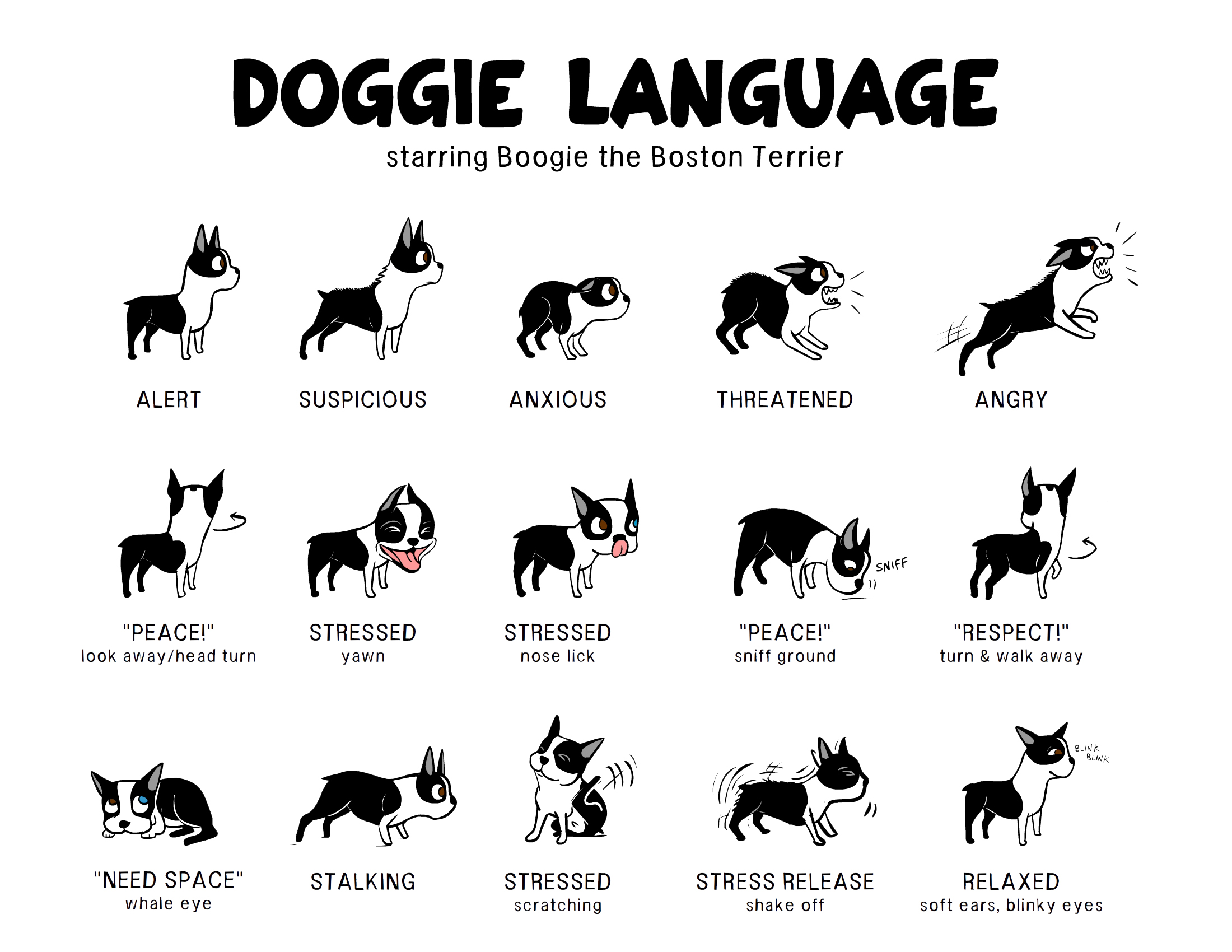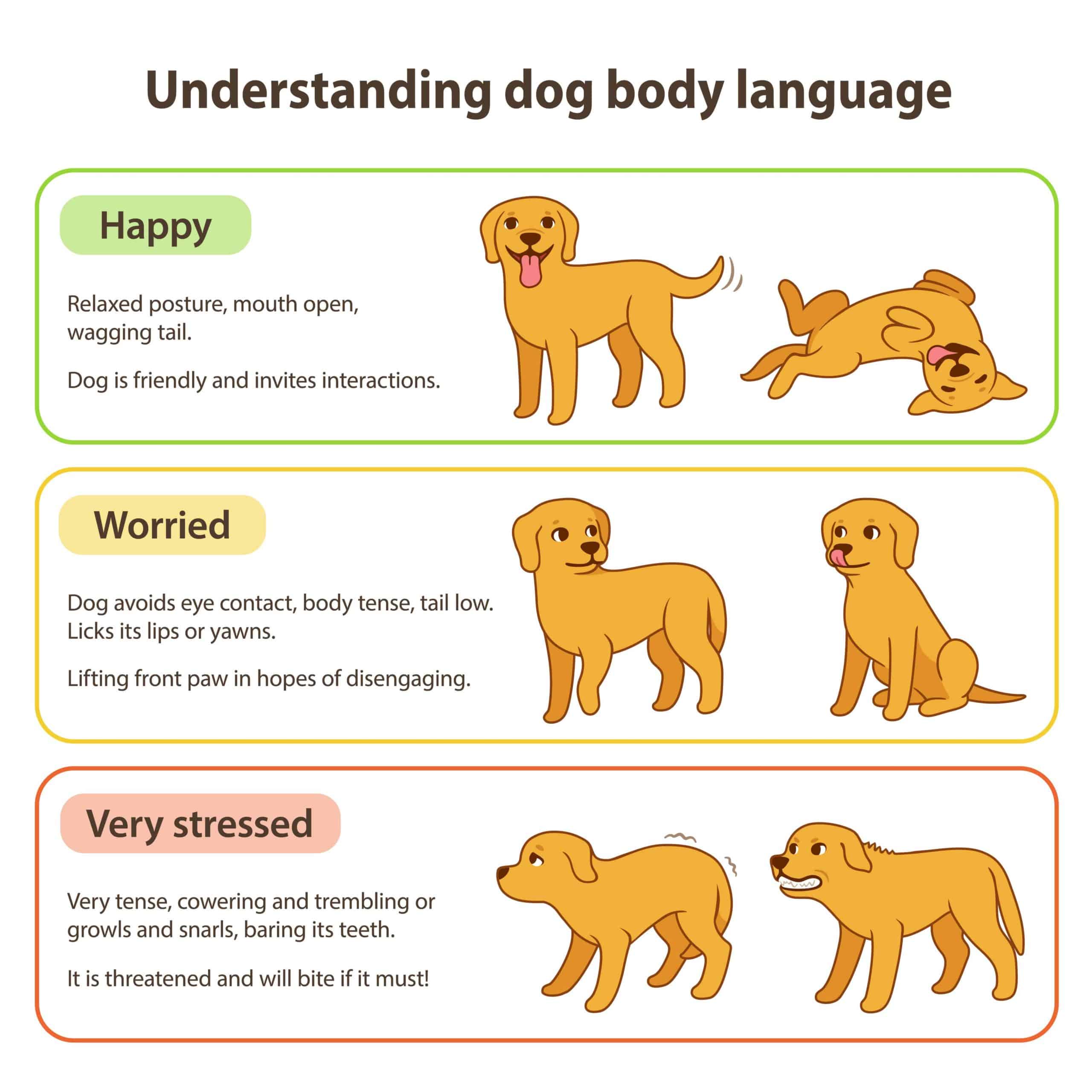Dog Body Language Chart: Unlocking Canine Communication
Understanding a dog’s body language is crucial for effective communication and building a strong bond. This comprehensive guide delves into the intricacies of canine body language, deciphering facial expressions, body postures, tail movements, and vocalizations to unravel the unspoken language of our furry companions.
Dog Body Language Overview
Understanding dog body language is crucial for effective communication and building a strong bond with your canine companion. Dogs communicate a wide range of emotions and intentions through their body language, including their posture, facial expressions, tail movements, and vocalizations.
By interpreting these signals, you can better understand your dog’s needs, feelings, and motivations, leading to a more harmonious and fulfilling relationship.
Types of Body Language Signals, Dog body language chart
Dog body language signals can be broadly categorized into the following types:
- Posture:A dog’s posture can convey a range of emotions, from confidence and alertness to fear and submission.
- Facial Expressions:Dogs’ facial expressions are highly expressive, and they can communicate emotions such as happiness, fear, aggression, and pain through their ears, eyes, and mouths.
- Tail Movements:A dog’s tail is a versatile communication tool. Different tail positions and movements can indicate a range of emotions, from excitement and happiness to anxiety and fear.
- Vocalizations:While vocalizations are not strictly body language, they play a significant role in canine communication. Dogs use barking, howling, whining, and growling to express various emotions and intentions.
Facial Expressions: Dog Body Language Chart
Dogs communicate a wide range of emotions through their facial expressions, which can provide valuable insights into their mood, intentions, and overall well-being. Understanding how to interpret these expressions is crucial for effective communication and bonding with our canine companions.
The key to interpreting a dog’s facial expressions lies in observing the context and combining it with other body language cues. For example, a dog with a relaxed body and a soft, open mouth may be expressing contentment, while the same expression accompanied by tense muscles and a raised tail could indicate aggression.
Common Facial Expressions and Their Meanings
| Expression | Meaning | Context | Additional Cues |
|---|---|---|---|
| Relaxed mouth, slightly open | Contentment, relaxation | Calm body posture, wagging tail | – |
| Tightly closed mouth, lips drawn back | Aggression, fear, anxiety | Tense body, raised tail, dilated pupils | – |
| Lip licking | Apprehension, discomfort | Submissive posture, avoidance of eye contact | – |
| Raised eyebrows, furrowed brow | Alertness, curiosity | Head tilted, ears forward | – |
Body Posture
Body posture is a key aspect of canine communication. It provides valuable insights into a dog’s mood, health, and intentions. By observing a dog’s posture, we can better understand their emotional state and predict their behavior.
There are several common body postures that dogs adopt, each with its own significance. These include:
Relaxed and Comfortable
- Lying down with legs extended or curled up
- Sitting with head resting on paws
- Standing with weight evenly distributed
Alert and Attentive
- Standing with ears forward and tail raised
- Sitting with head held high and eyes focused
- Lying down with head raised and body tense
Defensive or Fearful
- Crouching with head lowered and tail tucked
- Standing with back arched and hackles raised
- Lying down with body flattened against the ground
Aggressive or Dominant
- Standing with chest puffed out and head held high
- Tail raised and wagging slowly
- Ears forward and body tense
Tail Movements

The tail is a highly expressive part of a dog’s body. It can convey a wide range of emotions and intentions, from happiness and excitement to fear and aggression. By understanding the different types of tail movements, you can better communicate with your dog and understand their needs.
Tail movements can be divided into two main categories: high tail movements and low tail movements. High tail movements are generally associated with positive emotions, while low tail movements are often associated with negative emotions.
High Tail Movements
- Wagging:A wagging tail is a sign of happiness and excitement. The faster the wag, the more excited the dog is.
- Held high:A dog that holds its tail high is confident and alert.
- Curled over the back:A dog that curls its tail over its back is submissive and fearful.
Low Tail Movements
- Tucked between the legs:A dog that tucks its tail between its legs is scared or anxious.
- Low and wagging slowly:A dog that wags its tail slowly and low is unsure or nervous.
- Held low and stiff:A dog that holds its tail low and stiff is aggressive or defensive.
Vocalizations

Dogs communicate through a wide range of vocalizations, each with its own unique meaning. These vocalizations can indicate a dog’s needs, emotions, and intentions, and it is important for dog owners to be able to interpret them correctly.
Some of the most common types of vocalizations that dogs use include barking, howling, growling, whining, and whimpering. Each of these vocalizations can have multiple meanings, depending on the context in which it is used. For example, a dog may bark to alert its owner to a stranger, to express excitement or playfulness, or to show aggression.
Barking
- Dogs bark for a variety of reasons, including to alert their owners to strangers, to express excitement or playfulness, or to show aggression.
- The pitch and duration of a dog’s bark can vary depending on its mood and intentions.
- A high-pitched, short bark is often a sign of excitement or playfulness, while a low-pitched, prolonged bark is more likely to be a sign of aggression.
Howling
- Dogs howl for a variety of reasons, including to communicate with other dogs, to express loneliness or boredom, or to show pain.
- Howling is often a long, drawn-out vocalization that can be heard over long distances.
- Dogs may also howl in response to certain sounds, such as sirens or music.
Growling
- Dogs growl to warn others to stay away.
- Growling is often accompanied by other body language cues, such as bared teeth and raised hackles.
- It is important to respect a dog’s growl and to give it space.
Whining
- Dogs whine for a variety of reasons, including to express hunger, thirst, or pain.
- Whining can also be a sign of anxiety or stress.
- It is important to pay attention to your dog’s whining and to try to determine the cause.
Whimpering
- Dogs whimper for a variety of reasons, including to express fear, pain, or submission.
- Whimpering is often a high-pitched, soft vocalization that can be difficult to hear.
- It is important to pay attention to your dog’s whimpering and to try to determine the cause.
Ending Remarks

By mastering the art of interpreting dog body language, we not only enhance our communication with our canine friends but also deepen our understanding of their emotional states and intentions. This knowledge empowers us to provide tailored care, foster meaningful interactions, and create a harmonious coexistence between humans and dogs.
FAQ Section
What are the key principles of dog body language?
Understanding dog body language involves observing facial expressions, body postures, tail movements, and vocalizations. Each signal provides clues about a dog’s emotions, intentions, and overall well-being.
How can I interpret my dog’s facial expressions?
A dog’s facial expressions convey a wide range of emotions. A relaxed, open mouth with a lolling tongue indicates contentment, while a furrowed brow and bared teeth signal aggression. Context and other body language cues are crucial for accurate interpretation.
What do different body postures tell me about my dog?
Body postures provide insights into a dog’s mood and intentions. A playful dog may bounce around with a wagging tail, while a fearful dog may cower with its tail tucked between its legs.